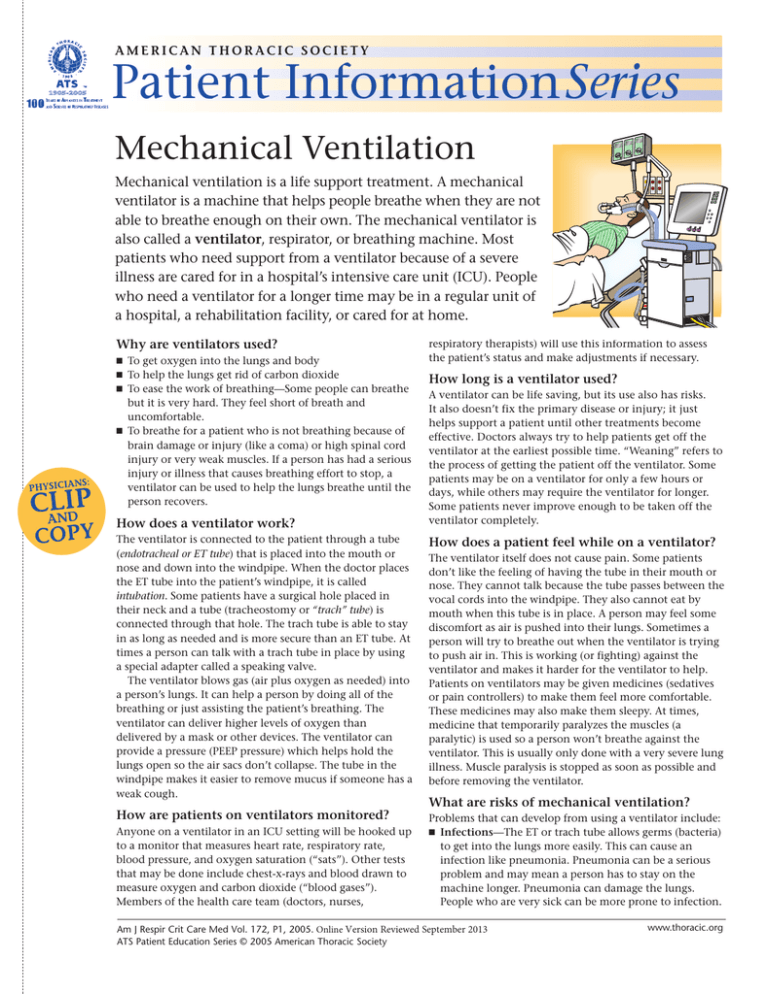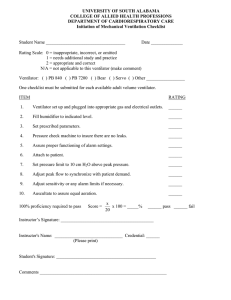Patient Information Series: Mechanical Ventilation
advertisement

AMERICAN THORACIC SOCIETY Patient Information Series Mechanical Ventilation Mechanical ventilation is a life support treatment. A mechanical ventilator is a machine that helps people breathe when they are not able to breathe enough on their own. The mechanical ventilator is also called a ventilator, respirator, or breathing machine. Most patients who need support from a ventilator because of a severe illness are cared for in a hospital’s intensive care unit (ICU). People who need a ventilator for a longer time may be in a regular unit of a hospital, a rehabilitation facility, or cared for at home. Why are ventilators used? ■ ■ ■ ■ To get oxygen into the lungs and body To help the lungs get rid of carbon dioxide To ease the work of breathing—Some people can breathe but it is very hard. They feel short of breath and uncomfortable. To breathe for a patient who is not breathing because of brain damage or injury (like a coma) or high spinal cord injury or very weak muscles. If a person has had a serious injury or illness that causes breathing effort to stop, a ventilator can be used to help the lungs breathe until the person recovers. How does a ventilator work? respiratory therapists) will use this information to assess the patient’s status and make adjustments if necessary. How long is a ventilator used? A ventilator can be life saving, but its use also has risks. It also doesn’t fix the primary disease or injury; it just helps support a patient until other treatments become effective. Doctors always try to help patients get off the ventilator at the earliest possible time. “Weaning” refers to the process of getting the patient off the ventilator. Some patients may be on a ventilator for only a few hours or days, while others may require the ventilator for longer. Some patients never improve enough to be taken off the ventilator completely. The ventilator is connected to the patient through a tube (endotracheal or ET tube) that is placed into the mouth or nose and down into the windpipe. When the doctor places the ET tube into the patient’s windpipe, it is called intubation. Some patients have a surgical hole placed in their neck and a tube (tracheostomy or “trach” tube) is connected through that hole. The trach tube is able to stay in as long as needed and is more secure than an ET tube. At times a person can talk with a trach tube in place by using a special adapter called a speaking valve. The ventilator blows gas (air plus oxygen as needed) into a person’s lungs. It can help a person by doing all of the breathing or just assisting the patient’s breathing. The ventilator can deliver higher levels of oxygen than delivered by a mask or other devices. The ventilator can provide a pressure (PEEP pressure) which helps hold the lungs open so the air sacs don’t collapse. The tube in the windpipe makes it easier to remove mucus if someone has a weak cough. How does a patient feel while on a ventilator? How are patients on ventilators monitored? Problems that can develop from using a ventilator include: ■ Infections—The ET or trach tube allows germs (bacteria) to get into the lungs more easily. This can cause an infection like pneumonia. Pneumonia can be a serious problem and may mean a person has to stay on the machine longer. Pneumonia can damage the lungs. People who are very sick can be more prone to infection. Anyone on a ventilator in an ICU setting will be hooked up to a monitor that measures heart rate, respiratory rate, blood pressure, and oxygen saturation (“sats”). Other tests that may be done include chest-x-rays and blood drawn to measure oxygen and carbon dioxide (“blood gases”). Members of the health care team (doctors, nurses, The ventilator itself does not cause pain. Some patients don’t like the feeling of having the tube in their mouth or nose. They cannot talk because the tube passes between the vocal cords into the windpipe. They also cannot eat by mouth when this tube is in place. A person may feel some discomfort as air is pushed into their lungs. Sometimes a person will try to breathe out when the ventilator is trying to push air in. This is working (or fighting) against the ventilator and makes it harder for the ventilator to help. Patients on ventilators may be given medicines (sedatives or pain controllers) to make them feel more comfortable. These medicines may also make them sleepy. At times, medicine that temporarily paralyzes the muscles (a paralytic) is used so a person won’t breathe against the ventilator. This is usually only done with a very severe lung illness. Muscle paralysis is stopped as soon as possible and before removing the ventilator. What are risks of mechanical ventilation? Am J Respir Crit Care Med Vol. 172, P1, 2005. Online Version Reviewed September 2013 ATS Patient Education Series © 2005 American Thoracic Society www.thoracic.org ATS PATIENT INFORMATION SERIES ■ ■ ■ ■ Pneumonia can often be treated with antibiotic medicines. Collapsed lung (pneumothorax)—Sometimes, a part of the lung that is weak can become too full of air and start to leak. The leak lets air get into the empty space between the lung and the chest wall. Air in this space takes up room so the lung starts to collapse. If this air leak happens, the air needs to be removed from this space. Doctors can place a different kind of tube (chest tube) into the chest between the ribs to drain out the extra air. The tube allows the lung to re-expand and seal the leak. The chest tube usually has to stay in for some time to make sure the leak has stopped and get all the extra air out. Rarely, a sudden collapse of the lung can cause death. Lung damage—The pressure of putting air into the lungs with a ventilator can damage the lungs. Doctors try to keep this risk at a minimum by using the lowest amount of pressure that is needed. Very high levels of oxygen may be harmful to the lungs as well. Doctors only give as much oxygen as it takes to make sure the body is getting enough to supply vital organs. Sometimes it is hard to reduce this risk when the lungs are damaged. This damage can sometimes heal if a person is able to recover from the serious illness. Side effects of medications—At times sedation medicines can build up and the patient may remain in a deep sleep for hours to days, even after the medicine is stopped. The doctors and nurses try to adjust the right amount of medication for a patient. Different patients will react to each medicine differently. If muscle paralysis is needed, at times the muscles are weak for a while after it is stopped. This will get better over time. Maintenance of Life—For patients who are very sick, at times the ventilator only postpones death. Not every patient improves just because they use a ventilator. It is hard to predict or know for sure if a person will recover with treatment. Sometimes the doctors feel very sure the ventilator will help and the patient will recover. Other times, the doctors can only give a rough idea of the chances that a person will survive. Doctors may have to ask the patient (or next of kin) if the ventilator should be continued if the patient is not recovering or is getting worse. While patients can die even though they are hooked up to a ventilator, sometimes the ventilator seems to prolong the dying process. How can I make my wishes about using a ventilator known? Mechanical ventilation is a “life-sustaining treatment”. It is a treatment that can prolong life. It may be needed for only a short time. However, some patients cannot be weaned off the ventilator and do not want to stay on the machine. Other patients who know they have a very severe lung or health problem may not even want to use a ventilator at all. That is because the ventilator cannot fix their main disease. Some patients have very specific thoughts about if and when they should be placed on a ventilator. Although doctors help patients and their families make tough decisions about the end of life, it is the patient who has the final say. If a patient cannot talk or communicate decisions, doctors will talk with the patient’s legally authorized representative (usually a parent, wife or husband or next of kin). It is important that you talk with your family members and your doctors about using a ventilator and what you would like to happen in different situations. The more clearly you explain your values and choices to friends, loved ones and doctors, the easier it is that they will be able to follow your wishes if and when you are unable to make decisions yourself. Advance directives are ways to also put your wishes in writing to share with others. In the hospital, nurses, doctors and social workers can provide information about an advance directive form. You can also obtain information on advance directives from your family doctor, state Attorney General’s office, public health department, or organizations such as Aging With Dignity (www.agingwithdignity.org) Source: Manthous, C., Tobin, MJ. A Primer on Critical Care for Patients and Their Families Additional Resources American Thoracic Society www.thoracic.org ATS Patient Advisory Roundtable www.thoracic.org/aboutats/par/par.asp National Heart Lung & Blood Institute www.nhlbi.nih.gov/health/dci/Diseases/Ards/Ards_ Treatmens.html Family Caregiver Alliance National Center on Caregiving http://www.caregiver.org Aging With Dignity www.agingwithdignity.org What to do… ✔ Ask the doctor to explain why a ventilator is needed ✔ Share any concerns you have about use of the ventilator ✔ Wash hands to help avoid spread of infection ✔ Work with medical staff to help the patient be as comfortable as possible. Doctor’s Office Telephone: The ATS Patient Information Series is a public service of the American Thoracic Society and its journal, the AJRCCM. The information appearing in this series is for educational purposes only and should not be used as a substitute for the medical advice one one’s personal health care provider. For further information about this series, contact J.Corn at jcorn@thoracic.org. www.thoracic.org

